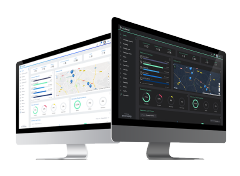
Greenhouse effect & climate change
Sustainability | Environment | Pollution | Climate changeCombustion vehicles generate greenhouse gases emissions that accelerate climate change, increase global warming and greenhouse effect.
Combustion vehicles, among others, generate a large amount of GHG (Greenhouse Gases) emissions, which increase the greenhouse effect and the climate change of our planet. This also causes serious consequences such as the alarming Greenland thaw that we are already living.
The greenhouse effect is a completely natural phenomenon of the planet thanks to which the temperature of the Earth is compatible with life. In short, the process begins with the Sun radiation when it reaches our planet. A part of this energy is absorbed into the atmosphere; another part is reflected by clouds and the rest reaches the earth's surface by heating it.
Once this solar radiation has warmed our surface, the Earth returns part of the energy to the atmosphere, but precisely greenhouse gases effect retain about 63% of the total of this energy inside the Earth, which causes that the temperature of the planet increases gradually.
Well, without this greenhouse effect, the average temperature of the planet would be much lower, around -18ºC, so it won’t be possible to develop any kind of life.
And then, why are GHGs harmful?
The reason is simple, because as the greenhouse gases increase on the planet, the amount of energy retained is also greater, and consequently the temperature of the atmosphere continues rising. And what causes this fact? Global warming and the famous Climate Change, which we are accelerating to a giant rhythm due to the artificial and disproportionate increase of GHGs, among other reasons.
Main consequences
One of the main consequences and most serious is the thawing of polar ice caps and glaciers, which cause flooding of islands and coastal cities.
In fact, since the end of July Greenland is suffering a heat wave that worries the scientific community, since the temperatures are four times higher than the usual ones at this season (they are usually 3 degrees and almost 20 degrees have been reached).
This means a maximum alert level since the extreme thaw is occurring could cover Florida with 12 centimeters or Germany with 7 centimeters of water. To be more specific, on August 1, 11 billion tons of Greenland gel were melted, a figure never recorded.
The planet is in danger
And what else causes climate change and GHGs? Neither more nor less than all this:
More devastating hurricanes due to their greater intensity
Reduction of rainfall caused by heat waves, leading to droughts and water shortages
Migration of species and desertification of fertile areas, which has an impact on agriculture and animal husbandry, through invasive grasses, insect proliferation and diseases that affect multiple crops
Food shortages, especially in poor countries, due to the decline in agricultural production
Extinction of species and invasions by exotic species
Propagation of diseases and pandemics caused by extreme heat
And we are not talking about hypothetical cases, we are talking about the reality we already live today.
Did you know that if Greenland's ice melted, sea level could rise up to 7 meters?
It’s estimated that 75% of the glaciers in the Swiss Alps may disappear by 2050 if we continue at the frenetic pace of generating polluting gases. Consequently, sea level would rise and entire islands and coastal areas would be flooded. In Europe around 70 million habitants would be in danger, and on the whole planet, a total of 90 million.
And what can we do to reduce these GHGs?
Well, we can say that the vast majority of sources of pollution are beyond the control of each of us, and usually require measures by administrations. And then, how can we reduce such air pollution?
As individual people, every little step and every little action counts. We can promote the energy transition using non-polluting means of transport, bet on energy efficient homes, try to supply ourselves with renewable energy through self-consumption and photovoltaic energy and, of course, by using the electric vehicle (EV).
In addition, other measures that we can take into account are the reduction of consumerism, the elimination of plastics in our daily lives, the reduction of meat consumption, recycling and consume organic products.
Which are the main greenhouse gases?
We can stipulate that the main GHGs are:
Carbon dioxide (CO2): occurs when a carbon compound burns in excess of oxygen. It’s naturally emitted in volcanic eruptions, forest fires, decomposition of organic matter and respiratory processes. Human sources have triggered CO2 concentrations since the Industrial Revolution, reaching 60% of the gases that cause the greenhouse effect.
Methane (CH4): occurs when organic matter decomposes in oxygen-free environments. It’s naturally emitted in oceans, termites and wetlands. Human sources emit it by burning fossil fuels, raising cattle, decomposing waste in landfills and rice stalks, among others. It’s considered the second most important greenhouse gas.
Ozone (O3): ozone is a gas that exists naturally in the atmosphere. In it, and more specifically in the stratosphere, it’s present through the ozone layer, which is very beneficial and necessary for the Earth since it prevents ultraviolet light from reaching the surface and thus helps to avoid possible cancers and damage to the vegetation. But ozone much closer to the ground (tropospheric ozone) is a very dangerous gas, since it has a high oxidation power. It usually occurs from traffic and industry emissions through the synthesis of organic compounds, and causes irreversible damage to animals and plants. It’s considered the third most important greenhouse gas and some of its precursor gases are nitrogen oxide (NOx), carbon monoxide (CO) and methane (CH4).
Other gases: nitrous oxide (N2O), chlorofluorocarbons (CFC), sulfur dioxide (SO2), hydrofluorocarbons (HCFC) or sulfur hexafluoride (SF6), used in aluminum production, aerosols, air conditioners, fuel burning fossils and organic matter, nylon production, agricultural fertilizers, heating, electricity generation, vehicle engines...
Building a better world for future generations is in our hands!
We live in the society of the immediacy and this has led us to use the car absolutely for everything, without realizing that, in many cases, it makes no sense and, in addition, is a greater waste of time than we imagine. If we used public transport, PMV (personal mobility vehicles) and even if we were on foot, we would spare the fact of congesting the streets of the city, wasting time looking for parking and, above all, contributing to no longer pollute our lives!
And as for an EV, we can say that it generates less GHG emissions throughout its useful life compared to a conventional car (including its manufacture, use and subsequent recycling / scrapping), although we don’t have energy renewable electricity and we talk about generating electricity based on non-renewable sources, which in many countries is unfortunately still so.
There is a method of analysis called Well to Wheel: from the oil well to the wheel, which takes into account the CO2 emitted both to extract, transport and process the oil needed to make cars and produce gasoline and lubricants for use, such as CO2 emitted when manufacturing an electric and generating the electricity that moves it.
This method demonstrates that, although the manufacture of an electric has 15% more CO2 emissions associated with it than a thermal one (mainly due to battery production), this difference is compensated after only 20,000km.
Conclusion is simple and obvious; driving an EV harms the environment much less, not only because of the 0 emissions of pollutant particles and gases during use, but also because of the lower pollution even taking into account that the energy used is produced from non-renewable sources.
Furthermore, did you know that an EV has a yield of around 95% when one of gasoline or diesel barely reaches 30%?
Be part of the change!
In Place To Plug we dream in the future (rather near) where our children can breathe clean air, in a world where we move exclusively thanks to renewable energy. And you?
So, knowing all this information, do you want to continue breathing air that not only harms the environment, but also directly and indirectly damages your health? If you want to be part of the change and fight for a better and more sustainable world, where environmental and social well-being is prioritized, switch to electric!
💙 And how Place to Plug contributes to the environment and sustainability?
By empowering you to use electric vehicles offering an end to end solution for the entire EV charging industry, whether if you are an EV driver, a developer, a business or an institution!


Leave a comment